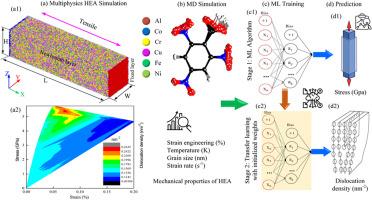Deformation mechanisms of AlCoCrCuFeNi: A molecular dynamics and machine learning approach
IF 8.2
2区 材料科学
Q1 MATERIALS SCIENCE, MULTIDISCIPLINARY
引用次数: 0
Abstract
High-entropy alloys (HEAs) distinguish themselves from other multi-component alloys through their unique nanostructures and mechanical properties. This study employs molecular dynamics (MD) simulations and machine learning to investigate the deformation mechanisms of AlCoCuCrFeNi HEA under varying temperatures, strain rates, and average grain sizes. The modeling results show that interactions between partial dislocations in AlCoCrCuFeNi HEA during tension and compression deformation cause various lattice disorders. The effect of temperature, strain rates, and grain boundaries on lattice disorder, plastic deformation behavior, dislocation density, and von-Mises stress (VMS) is disclosed. This study offers new insights into the atomic-scale deformation mechanisms governing the mechanical behavior of AlCoCrCuFeNi HEAs. It also presents a comprehensive workflow for predicting the mechanical properties of this HEA using machine learning models. The proposed approach provides several advantages, including significantly reduced simulation time and robust model validation. By employing the machine learning model trained in Stage 1, the time needed to simulate mechanical properties in Stage 2 is significantly decreased. Additionally, the framework ensures that the machine learning model effectively captures and understands the underlying representations of the mechanical properties of HEAs, thereby enhancing both the efficiency and accuracy of the predictions.

AlCoCrCuFeNi的变形机制:分子动力学和机器学习方法
高熵合金(HEAs)以其独特的纳米结构和力学性能区别于其他多组分合金。本研究采用分子动力学(MD)模拟和机器学习技术研究了不同温度、应变速率和平均晶粒尺寸下AlCoCuCrFeNi HEA的变形机制。模拟结果表明,在拉伸和压缩变形过程中,AlCoCrCuFeNi HEA中部分位错之间的相互作用导致了各种晶格紊乱。揭示了温度、应变速率和晶界对晶格无序性、塑性变形行为、位错密度和von-Mises应力(VMS)的影响。本研究为研究控制AlCoCrCuFeNi HEAs力学行为的原子尺度变形机制提供了新的见解。它还提出了一个使用机器学习模型预测HEA机械性能的综合工作流程。所提出的方法具有几个优点,包括显著减少仿真时间和鲁棒模型验证。通过使用第一阶段训练的机器学习模型,第二阶段模拟机械性能所需的时间大大减少。此外,该框架确保机器学习模型有效地捕获和理解HEAs机械特性的底层表示,从而提高预测的效率和准确性。
本文章由计算机程序翻译,如有差异,请以英文原文为准。
求助全文
约1分钟内获得全文
求助全文
来源期刊

Materials Today Nano
Multiple-
CiteScore
11.30
自引率
3.90%
发文量
130
审稿时长
31 days
期刊介绍:
Materials Today Nano is a multidisciplinary journal dedicated to nanoscience and nanotechnology. The journal aims to showcase the latest advances in nanoscience and provide a platform for discussing new concepts and applications. With rigorous peer review, rapid decisions, and high visibility, Materials Today Nano offers authors the opportunity to publish comprehensive articles, short communications, and reviews on a wide range of topics in nanoscience. The editors welcome comprehensive articles, short communications and reviews on topics including but not limited to:
Nanoscale synthesis and assembly
Nanoscale characterization
Nanoscale fabrication
Nanoelectronics and molecular electronics
Nanomedicine
Nanomechanics
Nanosensors
Nanophotonics
Nanocomposites
 求助内容:
求助内容: 应助结果提醒方式:
应助结果提醒方式:


